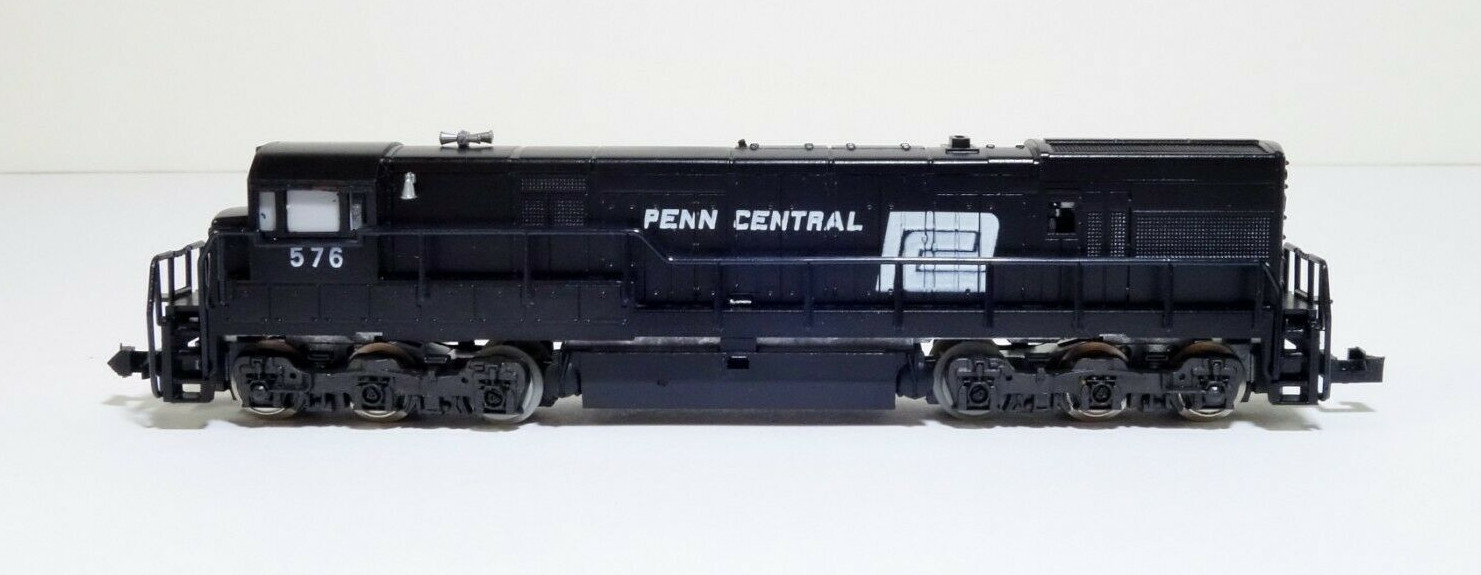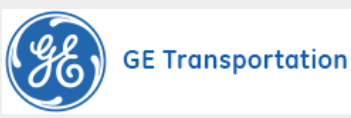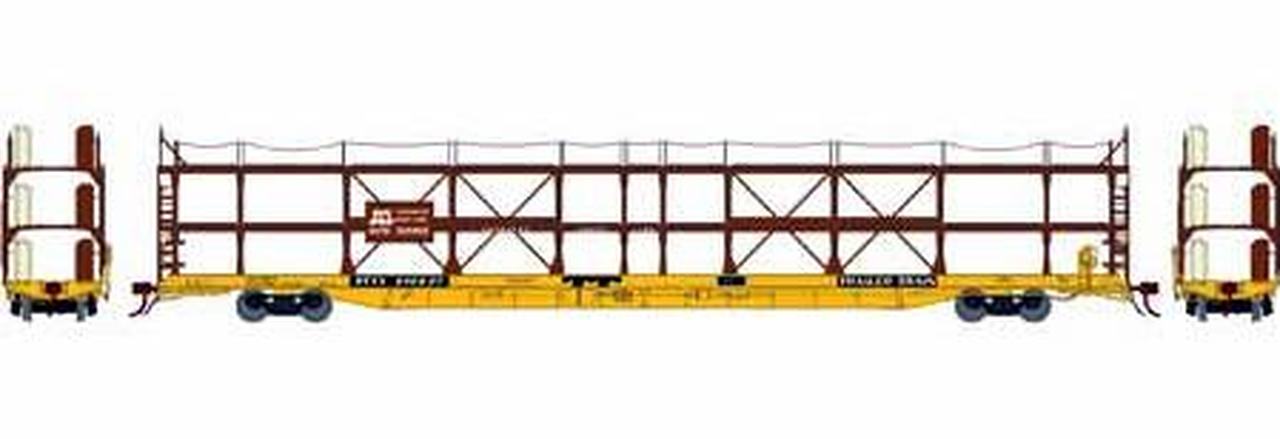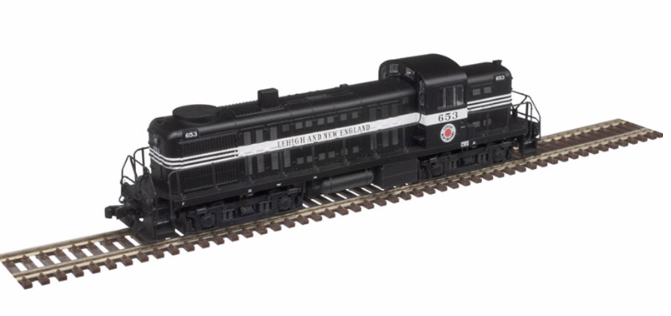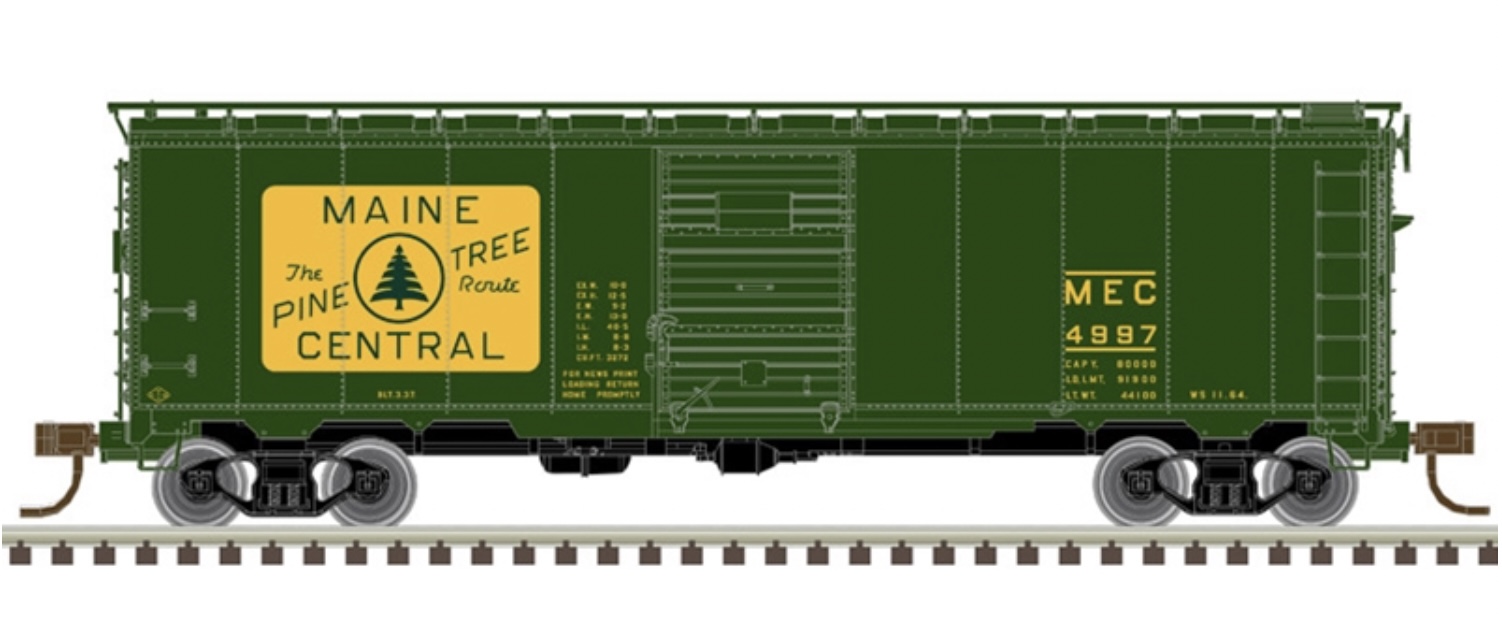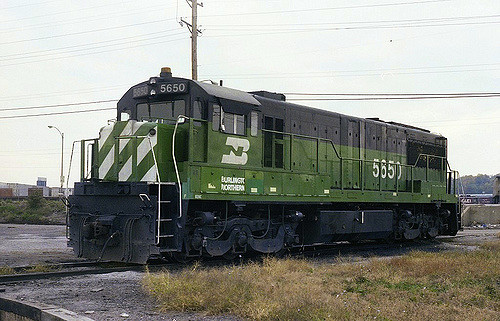Minitrix - 2007 - Locomotive, Diesel, GE U28C - Penn Central - 576
Click to see the details
market
Click to see the details
history
Click to see the details
collector
| Stock Number | 2007 |
| Original Retail Price | $20.00 |
| Brand | Minitrix |
| Manufacturer | Minitrix |
| Body Style | Minitrix Diesel Engine U28C |
| Prototype Vehicle | Locomotive, Diesel, GE U28C (Details) |
| Road or Company Name | Penn Central (Details) |
| Road or Reporting Number | 576 |
| Paint Color(s) | Black |
| Print Color(s) | White |
| Coupler Type | Rapido Hook |
| Wheel Type | Nickel-Silver Plated Metal |
| Wheel Profile | Standard |
| DCC Readiness | No |
| Release Date | 1971-01-01 |
| Item Category | Locomotives |
| Model Type | Diesel |
| Model Subtype | GE Transportation |
| Model Variety | U28C |
| Prototype Region | North America |
| Prototype Era | NA Era IV: 2nd Gen Diesel (1958 - 1978) |
| Scale | 1/160 |
Specific Item Information:
Made in Western Germany and first sold in the US under the Postage Stamp Trains brand, the Minitrix EMD F9A/B, FM H12-44, GE U28C, and GE U30CG, diesels and the 0-6-0, 4-6-2, and 2-10-0 steam locomotives were initially imported by the Aurora Plastics Corp. in the late 1960s. Following Aurora's demise, American Tortoise, Con-Cor, and finally the now defunct Model Power resumed the importation and sales of these models. Sold by Model Power, the engine depicted here is now discontinued.
Prototype History:
The U28C was developed by General Electric from the U25C, with a slight increase in power of 300 hp (224 kW).[2] A passenger-hauling variant, the U28CG, was also produced for the Atchison, Topeka and Santa Fe Railway.
General Electric built ten uprated U25Cs in 1965. Facing the competitive pressure of the second generation horsepower race, GE built these units with increased horsepower. The competitive 2750 horsepower Alco C628 had more horsepower and the 3000 horsepower Alco C630 was announced in July 1965. General Motors had the 3000 horsepower EMD SD40 demonstrators testing on several railroads. The increase in unit horsepower was happening that year. The uprated units were built for three railroads that were already operating the U25C. The first uprated units were built for the Northern Pacific between May and July 1965. These were NP #2518-2520 and were rated at 2750 horsepower. Three more uprated U25Cs were built as Atlantic Coast Line #3011-3013 in December 1965. The ACL units were rated at 2800 horsepower. The last four uprated U25Cs were rated at 2800 horsepower and were built for the Pennsylvania Railroad in December 1965. These were PRR #6516-6519. Six additional PRR U25Cs were uprated to 2800 horsepower: 6500-6503, 6510-6511. In early 1966 General Electric began offering the 2800 horsepower U28C. A total of 28 look-a-like U28Cs were built between February 1966 and July 1966 as Chicago Burlington and Quincy #562-577 and Northern Pacific #2800-2811. These early Phase I U28Cs shared the 64 foot 4 inch frame that was standard with the predecessor U25C.
A drawing of the proposed longer frame U28C is in the November 1965 issue of Trains Magazine. Starting in May 1966 GE began producing the U28C on a longer frame. The new length for these U28Cs was 67 feet 3 inches. These are the 43 Phase II units built for Louisville and Nashville, Pennsylvania, Southern Pacific and Union Pacific. The Phase II units used either the General Electric GT 598 Generator or the GTA 9 Alternator. The 10 Santa Fe U28CGs were also built on this longer frame. Starting in November 1966 and through mid 1967 GE built 24 look a like Phase I U30Cs that used the same carbody as the Phase II U28Cs.
General Electric built ten uprated U25Cs in 1965. Facing the competitive pressure of the second generation horsepower race, GE built these units with increased horsepower. The competitive 2750 horsepower Alco C628 had more horsepower and the 3000 horsepower Alco C630 was announced in July 1965. General Motors had the 3000 horsepower EMD SD40 demonstrators testing on several railroads. The increase in unit horsepower was happening that year. The uprated units were built for three railroads that were already operating the U25C. The first uprated units were built for the Northern Pacific between May and July 1965. These were NP #2518-2520 and were rated at 2750 horsepower. Three more uprated U25Cs were built as Atlantic Coast Line #3011-3013 in December 1965. The ACL units were rated at 2800 horsepower. The last four uprated U25Cs were rated at 2800 horsepower and were built for the Pennsylvania Railroad in December 1965. These were PRR #6516-6519. Six additional PRR U25Cs were uprated to 2800 horsepower: 6500-6503, 6510-6511. In early 1966 General Electric began offering the 2800 horsepower U28C. A total of 28 look-a-like U28Cs were built between February 1966 and July 1966 as Chicago Burlington and Quincy #562-577 and Northern Pacific #2800-2811. These early Phase I U28Cs shared the 64 foot 4 inch frame that was standard with the predecessor U25C.
A drawing of the proposed longer frame U28C is in the November 1965 issue of Trains Magazine. Starting in May 1966 GE began producing the U28C on a longer frame. The new length for these U28Cs was 67 feet 3 inches. These are the 43 Phase II units built for Louisville and Nashville, Pennsylvania, Southern Pacific and Union Pacific. The Phase II units used either the General Electric GT 598 Generator or the GTA 9 Alternator. The 10 Santa Fe U28CGs were also built on this longer frame. Starting in November 1966 and through mid 1967 GE built 24 look a like Phase I U30Cs that used the same carbody as the Phase II U28Cs.
Road Name History:
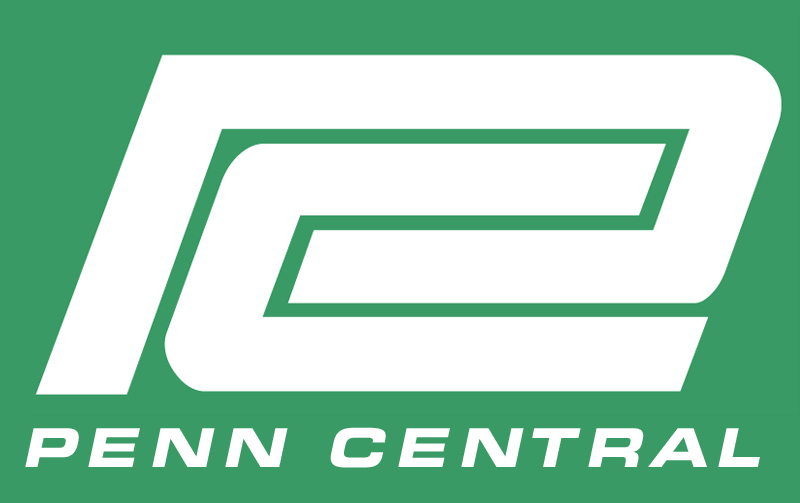 The Penn Central Transportation Company, commonly abbreviated to Penn Central, was an American Class I railroad headquartered in Philadelphia, Pennsylvania, that operated from 1968 until 1976. It was created by the 1968 merger of the Pennsylvania and New York Central railroads. The New York, New Haven & Hartford Railroad was added to the merger in 1969; by 1970, the company had filed for what was, at that time, the largest bankruptcy in U.S. history.
The Penn Central Transportation Company, commonly abbreviated to Penn Central, was an American Class I railroad headquartered in Philadelphia, Pennsylvania, that operated from 1968 until 1976. It was created by the 1968 merger of the Pennsylvania and New York Central railroads. The New York, New Haven & Hartford Railroad was added to the merger in 1969; by 1970, the company had filed for what was, at that time, the largest bankruptcy in U.S. history.
The Penn Central was created as a response to challenges faced by all three railroads in the late 1960s. The northeastern quarter of the United States, these railroads' service area, was the most densely populated region of the U.S. While railroads elsewhere in North America drew a high percentage of their revenues from the long-distance shipment of commodities such as coal, lumber, paper and iron ore, Northeastern railroads traditionally depended on a mix of services.
As it turned out, the merged Penn Central was little better off than its constituent roads were before. A merger implementation plan was drawn up, but not carried out. Attempts to integrate operations, personnel and equipment were not very successful, due to clashing corporate cultures, incompatible computer systems and union contracts. Track conditions deteriorated (some of these conditions were inherited from the three merged railroads) and trains had to be run at reduced speeds. This meant delayed shipments and personnel working a lot of overtime. As a result, operating costs soared. Derailments and wrecks became frequent, particularly in the midwest.
The American financial system was shocked when after only two years of operations, the Penn Central Transportation company was put into bankruptcy on June 21, 1970. It was the largest corporate bankruptcy in American history at that time. Although the Penn Central Transportation Company was put into bankruptcy, its parent Penn Central Company was able to survive.
The Penn Central continued to operate freight service under bankruptcy court protection. After private-sector reorganization efforts failed, Congress nationalized the Penn Central under the terms of the Railroad Revitalization and Regulatory Reform Act of 1976. The new law folded six northeastern railroads, the Penn Central and five smaller, failed lines, into the Consolidated Rail Corporation, commonly known as Conrail. The act took effect on April 1, 1976.
Read more on Wikipedia.

The Penn Central was created as a response to challenges faced by all three railroads in the late 1960s. The northeastern quarter of the United States, these railroads' service area, was the most densely populated region of the U.S. While railroads elsewhere in North America drew a high percentage of their revenues from the long-distance shipment of commodities such as coal, lumber, paper and iron ore, Northeastern railroads traditionally depended on a mix of services.
As it turned out, the merged Penn Central was little better off than its constituent roads were before. A merger implementation plan was drawn up, but not carried out. Attempts to integrate operations, personnel and equipment were not very successful, due to clashing corporate cultures, incompatible computer systems and union contracts. Track conditions deteriorated (some of these conditions were inherited from the three merged railroads) and trains had to be run at reduced speeds. This meant delayed shipments and personnel working a lot of overtime. As a result, operating costs soared. Derailments and wrecks became frequent, particularly in the midwest.
The American financial system was shocked when after only two years of operations, the Penn Central Transportation company was put into bankruptcy on June 21, 1970. It was the largest corporate bankruptcy in American history at that time. Although the Penn Central Transportation Company was put into bankruptcy, its parent Penn Central Company was able to survive.
The Penn Central continued to operate freight service under bankruptcy court protection. After private-sector reorganization efforts failed, Congress nationalized the Penn Central under the terms of the Railroad Revitalization and Regulatory Reform Act of 1976. The new law folded six northeastern railroads, the Penn Central and five smaller, failed lines, into the Consolidated Rail Corporation, commonly known as Conrail. The act took effect on April 1, 1976.
Read more on Wikipedia.
Brand/Importer Information:
Trix is a German company that originally made Trix metal construction sets. one of its co-founders was Stephan Bing, the son of the pioneer toy-maker industrialist Ignaz Bing. In 1935 the company began producing the electrically powered model trains that it became famous for, under the Trix Express label. Prior to the outbreak of World War II the Trix company produced a small range of fairly unrealistic AC powered three rail models running at 14 volts.
N gauge models under the Minitrix brand were made from the late 1960s mostly of European prototypes (German and British primarily). North American prototypes were also manufactured and marketed under the Aurora "Postage Stamp" brand; later these items were sold under the American Tortoise, Model Power and Con-Cor brands. Trix sometimes utilized North American consultants to aid in the design of this portion of the product line. The "Hornby Minitrix' brand was used in the 1980s for a short lived range of British outline models using the earlier product tooling.
Trix's owner in the 1980s and 1990s was Mangold, which went bankrupt in the late 1990s and Märklin purchased the assets in January 1997. In part, this purchase was a reflection of Märklin's need for added production capacity; Trix had been manufacturing certain items for Märklin in previous years. The purchase was also in response to the earlier purchase of the Karl Arnold company by the Italian company Rivarossi; Märklin were very keen to take over Trix market share in 2-rail H0 and especially Minitrix, until then Märklin had not marketed N gauge models. In 2003, Märklin introduced its first N gauge models under the well established Minitrix brand. A number Märklin H0 scale three-rail AC locomotives have also been introduced in two-rail DC versions under the Trix logo and many models are shared between the two brands.
From Wikipedia
N gauge models under the Minitrix brand were made from the late 1960s mostly of European prototypes (German and British primarily). North American prototypes were also manufactured and marketed under the Aurora "Postage Stamp" brand; later these items were sold under the American Tortoise, Model Power and Con-Cor brands. Trix sometimes utilized North American consultants to aid in the design of this portion of the product line. The "Hornby Minitrix' brand was used in the 1980s for a short lived range of British outline models using the earlier product tooling.
Trix's owner in the 1980s and 1990s was Mangold, which went bankrupt in the late 1990s and Märklin purchased the assets in January 1997. In part, this purchase was a reflection of Märklin's need for added production capacity; Trix had been manufacturing certain items for Märklin in previous years. The purchase was also in response to the earlier purchase of the Karl Arnold company by the Italian company Rivarossi; Märklin were very keen to take over Trix market share in 2-rail H0 and especially Minitrix, until then Märklin had not marketed N gauge models. In 2003, Märklin introduced its first N gauge models under the well established Minitrix brand. A number Märklin H0 scale three-rail AC locomotives have also been introduced in two-rail DC versions under the Trix logo and many models are shared between the two brands.
From Wikipedia
Item created by: nscalemodeler160
on 2016-04-08 10:38:19
Last edited by: RoadRailer on 2022-04-06 12:20:44
If you see errors or missing data in this entry, please feel free to log in and edit it. Anyone with a Gmail account can log in instantly.
Last edited by: RoadRailer on 2022-04-06 12:20:44
If you see errors or missing data in this entry, please feel free to log in and edit it. Anyone with a Gmail account can log in instantly.


